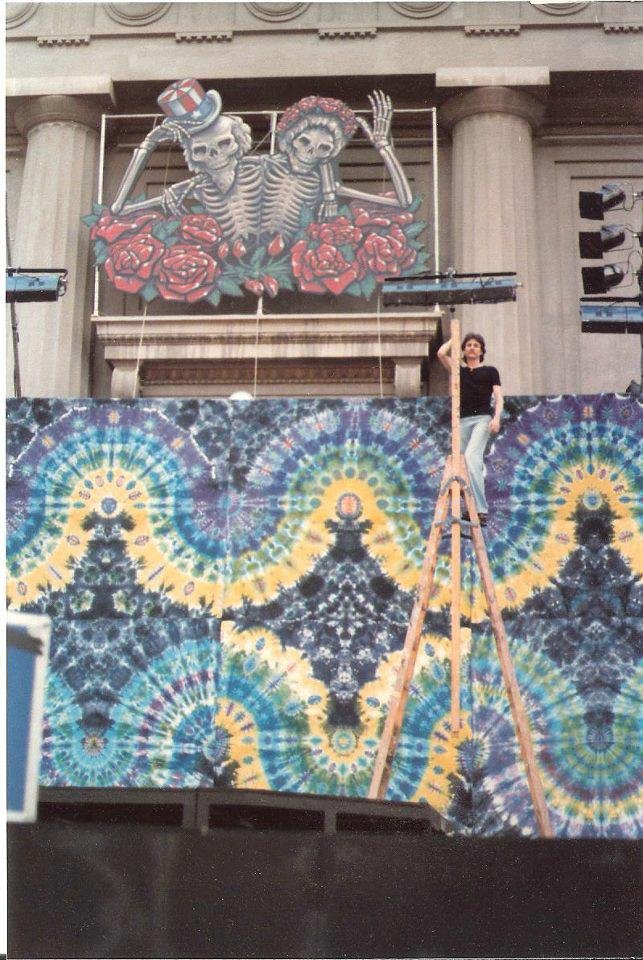An Enrapturing Conversation with Courtenay Pollock
Photo credit: Art Rogers
Courtenay Pollock is an internationally renowned American artist best known for his colorful, vibrant tie-dye backdrops and Mandalas. His art has been sought after by some of the world’s most iconic figures and bands, most notably the Grateful Dead and their countless “spinoff” bands that have used his legendary tie-dyed stage backdrops for more than 50 years. Known for his one-of-a-kind tie-dye style and technique he developed that reveals a compelling visual poetic to the eye. His art style represents the psychedelic art of the '60s and 70's and is merged with new-age visual expression. . Courtenay Pollock’s work has been included in exhibitions at the Museum of Art and Design, The New York Historical Society, Fine Art Museums of San Francisco, and Bonhams New York and elsewhere. I had the honor and pleasure of asking Courtenay about the inspiration behind his concept of tie-dying, what are some of his favorite moments when he looks back on his career and so much more.
UZOMAH: Jim Morrison of the "Doors" said, "When the music is over, turn off the lights." Has the show ever ended for you even though the scene is not like it once was in the 60s?
COURTENAY: The music never ends. Life goes on in all its glorious manifestations. A life well-lived is a creative process, I will continue to pursue that ‘perfect’ ineffable Courtenay tie-dye till my hands stop working. There are infinite variations that can be made using my folding geometry tie-dye method. Life is but a dream; a song filled with joy and love, tragedy and sorrow, and the highs and lows of laughter and loss.
Courtenay with Garcia at the Great Pyramid, Courtesy of artist.
U: What was the inspiration behind your concept of tie-dying?
C: I always loved working with colour as a child and that passion never dwindled as life and all its tolls continue to unfold. When I first saw tie-dye it was a simple sunburst on a sheet worn as a dress on a beautiful lady who came into my boutique in Greenwich Village in New York City. I thought about how to create concentric rings of colour and in that instant, my symmetrical folded geometry method was born complete.
Courtenay hanging the 81 Greek theatre backdrop, Courtesy of artist.
U: How was it like working with the Grateful Dead?
C: In those early years Rock and roll was still a work in progress, a constant improvisation being cobbled together from venue to venue as the situation demanded. We all had our small part to play towards the creation of the whole. The music continued to evolve through the creative imaginings of the band members and the work of producing the shows was a bit of a circus. We were a family of friends making it up as the needs arose, living together, playing together, and growing together.
Egypt Full Moon Eclipse over the pyramids 1978 Grateful Dead Concert, Courtesy of artist.
U: What are some of your favorite color combinations, and why?
C: There are seemingly endless combinations of colour progressions to be created with black, white, and the seven colours of the rainbow with all the nuances of each of those possibilities. I never tire of trying variations of colour progressions and contrasts. My personal taste in colour changes throughout the course of the years and seasons. Lately, I wear mostly monochromatic designs but still get a thrill from making brilliant psychedelic creations of art panels.
83 Greek Garcia with Chipollino. Photo credit Ed Perlstein
U: What is something people would not usually think about tie-dying that makes it even more enjoyable?
C: There are many styles of tie-dye, and many more variations not yet imagined. I love the endless possibilities of design and effect that continue to be created through all the different forms of method and styles. I’m always working towards that perfect piece but that appreciation is a matter of personal taste.
U: Can you describe your creative process when making a print or shirt?
C: I have a design and colour composition in mind for each piece I tie-dye but the results are so serendipitous and that is a big part of the joy of the creation.
1971 G.D. Stage set with new tie dye speakers by Courtenay Pollock. Courtesy of artist
U: How is creating with clothing any different than designing on a canvas or wall, or stage?
C: Cloth is a challenging medium to work with. It stretches, shrinks unevenly, and is never consistent from batch to batch. No two cotton fields produce just the same quality of raw material and the numerous styles of cloth present a continuing challenge in tie-dyeing as the cloth manufacturing industry tries various ways to make their product more profitable at the cost of good quality.
1979 Courtenay with Mandala. Photo by Art Rogers
U: What are some of your favorite moments when you look back on your career?
C: I loved inventing and creating the giant backdrops for the stage, such a wonderful challenge and a great showcase for my work. Each design invention had to be made in many separate panels that fit together into one continuous composition as though it were a single canvas.
U: What is the best live concert you have seen?
C: It was Paul McCartney at Rogers Arena-Auditorium in Vancouver around 2015 or thereabout.
For more information about Courtenay’s art, please visit his site and follow him on Instagram and Twitter.






